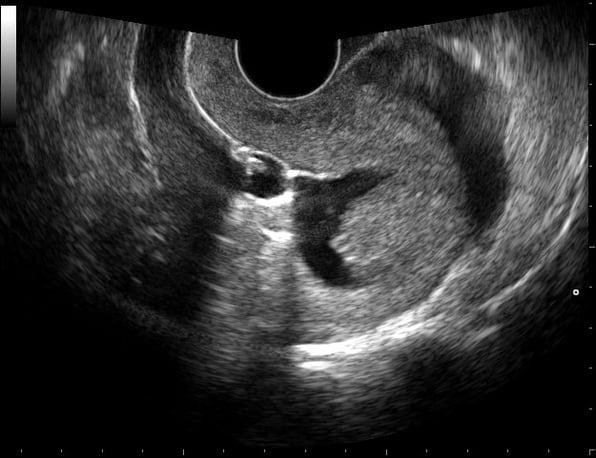
A sonohysterogram is a minimally invasive ultrasound imaging (also called “sonography”) procedure that allows a radiologist to examine the interior of the uterus and its lining (endometrium).
Why is a sonohysterogram done?
Your doctor might order a sonohysterogram to investigate the cause of infertility, repeated miscarriages, or abnormal uterine bleeding. It is a way of viewing the uterus and endometrium in order to identify abnormalities, such as
- Fibroids and other masses
- Polyps
- Endometrial atrophy or scarring
- Blood clots
- Pelvic varicose veins or aneurysms
- Congenital defects
How is it done?
A sonohysterogram begins with a transvaginal ultrasound. A wand-shaped transducer is wrapped in a protective cover, coated with lubricating gel, and inserted a few inches into the vagina in order to capture uterine images. The transducer is smaller in diameter than the speculum used in a standard gynecologic exam and should not cause notable discomfort. (If it does, let the technologist know.)
After the baseline transvaginal ultrasound is completed, the transducer is withdrawn, and a speculum is inserted. The cervix is cleaned, and a thin, flexible catheter is inserted through it into the uterine cavity. The speculum is then withdrawn and the transducer reinserted for further imaging. Sterile saline is injected through the catheter in order to enlarge the uterine cavity and obtain clearer images. The entire procedure takes approximately 60 minutes to complete.
Does it hurt?
Reports of pain during and after sonohysterography vary from a sensation of pressure to intense cramping. We recommend taking an over-the-counter pain medication 30 minutes prior to the procedure to minimize discomfort. Most women are able to resume a normal level of activity immediately following the procedure. However, it’s a good idea to plan to take it easy for the rest of the day to allow any extra recovery time you may desire.
What are the risks?
Sonohysterography is safe and well tolerated by most patients. Rarely, cases of pelvic infection follow sonohysterography. Contact your doctor immediately if you experience any of the following after your procedure:
- Fever
- Severe or increasing abdominal pain
- Generally feeling unwell
- Unusual or foul-smelling discharge (Spotting and watery discharge are normal for the first couple of days.)
What else should I know about the procedure?
- In order to minimize the risk of infection and obtain the clearest possible images, sonohysterography is not performed during menstruation.
- The ideal time to perform the test is one week following the end of menstruation, when the endometrium is thinnest. Scheduling your appointment for this time will provide the highest quality images.
- Sonohysterography is not performed during pregnancy. If there is a chance that you may be pregnant, inform your doctor prior to scheduling. You may be asked to take a pregnancy test to be sure before your appointment.
- You should not undergo a sonohysterogram if you currently have a pelvic or sexually transmitted infection. If it is possible that you have one of these conditions, ask your doctor to test for them prior to your procedure.
- Sonohysterography only assesses the uterus and endometrium. To identify abnormalities or obstructions in the fallopian tubes, a hysterosalpingogram is performed.
Iowa Radiology provides a wide range of imaging services to support women’s health, including digital and 3-D mammography, breast MRI and ultrasound, breast biopsy, bone density testing, cardiac calcium testing, hysterosalpingography, and sonohysterography.
We make every effort to answer all of our patients’ questions so they understand how to prepare for and what to expect during and after their exams or procedures. If you have questions about an upcoming procedure like an MRI, download our free guide to learn more about what to expect.
Sources
"Sonohystereography." Radiologyinfo.org. Radiological Society of North America, Inc., n.d. Web. 15 March 2016.
"Sonohysterogram." Stirrup Queens. Melissa S. Ford, 2006. Web. 15 March 2015.
"Sonohysterogram." WebMD.com. WebMD, LLC, n.d. Web. 15 March 2016.
"Sonohysterogram?... what to expect?" Babyandbump.momtastic.com. Evolve Media LLC, 2012. Web. 15 March 2015.
Image By © Nevit Dilmen, CC BY-SA 3.0, https://commons.wikimedia.org/w/index.php?curid=16711759
The information contained in the Iowa Radiology website is presented as public service information only. It is not intended to be nor is it a substitute for professional medical advice. You should always seek the advice of your physician or other qualified healthcare provider if you think you may have a medical problem before starting any new treatment, or if you have any questions regarding your medical condition. Iowa Radiology occasionally supplies links to other web sites as a service to its readers and is not in any way responsible for information provided by other organizations.


